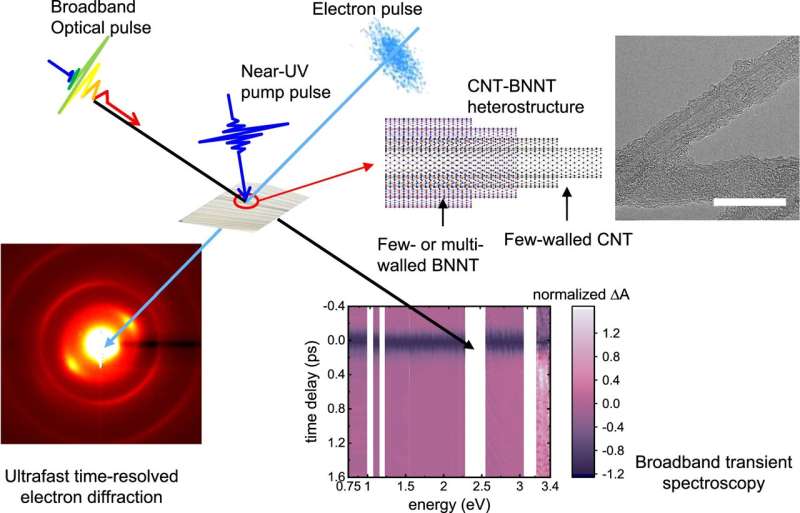This article has been reviewed according to Science X's editorial process and policies. Editors have highlighted the following attributes while ensuring the content's credibility:
fact-checked
peer-reviewed publication
trusted source
proofread
Unveiling novel energy phenomena from light exposure on layered materials

Research groups from the University of Tsukuba and the University of Rennes have discovered a novel phenomenon in which a nested structure of carbon nanotubes enveloped in boron nitride nanotubes facilitates a unique electron escape route when exposed to light. This finding introduces promising avenues for various applications, including the creation of high-speed optical devices, rapid control of electrons and other particles and efficient heat dissipation from devices.
Recent studies have highlighted that materials composed of layered tubes, which are atomically thick and classified as low-dimensional materials, exhibit new properties. Although the static properties of these structures, such as electrical conduction, are well documented, their dynamic properties, including electron transfer between layers and atomic motion triggered by light exposure, have received less attention.
In this study, researchers constructed nested cylindrical structures by wrapping carbon nanotubes (CNTs) in boron nitride nanotubes. They then examined the motion of electrons and atoms induced by ultrashort light pulses on a one-dimensional (1D) material. The study is published in the journal Nature Communications.
Electron motion was monitored using broadband ultrafast optical spectroscopy, which captures instantaneous changes in molecular and electronic structures due to light irradiation with a precision of ten trillionths of a second (10−13 s). Atomic motion was observed through ultrafast time-resolved electron diffraction, which similarly achieved monitoring of structural dynamics with ten-trillionth-of-a-second accuracy.
The study revealed that when different types of low-dimensional materials are layered, a pathway or channel forms, allowing electrons to escape from specific subparts of the material. Additionally, it was found that electrons excited in the CNTs by light exposure could transfer into the BNNTs via these electronic channels, where their energy is rapidly converted into thermal energy, facilitating extremely fast thermal conversion.
This research has uncovered a new physical phenomenon at the interface between two dissimilar materials, offering not only ultrafast thermal energy transport but also potential applications in the development of ultrafast optical devices and the rapid manipulation of electrons and holes generated by light.
More information: Yuri Saida et al, Photoinduced dynamics during electronic transfer from narrow to wide bandgap layers in one-dimensional heterostructured materials, Nature Communications (2024). DOI: 10.1038/s41467-024-48880-3
Journal information: Nature Communications
Provided by University of Tsukuba





















